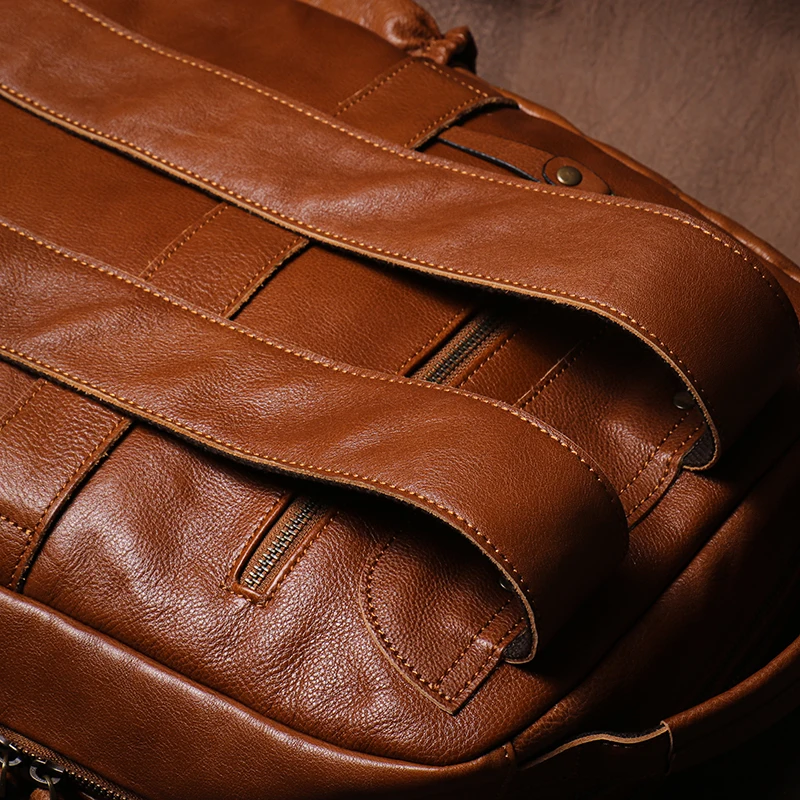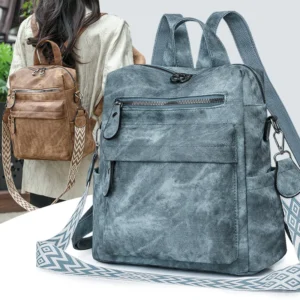Introduction: Preserving Your Leather Backpack’s Legacy
A quality leather backpack represents more than just a fashion statement—it’s an investment that can accompany you through decades of adventures. These timeless accessories develop character and charm with age, telling the story of your journeys through their evolving patina. But this transformation from new to beautifully aged only happens with proper care and attention.
Unlike synthetic materials that eventually deteriorate regardless of maintenance, leather responds remarkably to good stewardship. With appropriate care, a premium leather backpack can last not just years but generations, becoming an heirloom piece that gets better with time rather than wearing out.
The key to preserving your leather backpack lies in mastering four essential pillars of leather care: cleaning, conditioning, protecting, and storing. Each step plays a vital role in maintaining both the aesthetic appeal and structural integrity of your bag. Different leather types—from full-grain to suede—require specific approaches to leather conditioning and waterproofing techniques to maintain their unique characteristics.
At Summit Carry, we craft our backpacks using traditional leatherworking methods combined with modern design principles, giving us deep insight into proper leather maintenance practices.
Key aspects of leather care include:
– Regular cleaning to prevent dirt buildup
– Periodic conditioning to maintain suppleness
– Protective treatments to guard against environmental damage
– Proper storage techniques when not in use
Understanding Your Leather Backpack: Identifying Leather Types and Their Unique Needs
Before diving into maintenance techniques, it’s essential to identify what type of leather your backpack is made from. Each variety requires specific care approaches to maintain its distinctive qualities.
Full-Grain Leather
The highest quality leather available, full-grain leather backpacks feature the entire top layer of the hide with all natural markings and grain patterns intact. This premium material develops a beautiful patina over time while offering exceptional durability. Full-grain leather requires regular conditioning to maintain its suppleness but rewards this attention with decades of service.
Top-Grain Leather
Top-grain leather has had its uppermost layer sanded and buffed to remove imperfections. While still durable, it’s thinner and more pliable than full-grain. This type of leather often receives a light finishing coat that makes it somewhat more stain-resistant but also less breathable. Regular cleaning and conditioning are essential to prevent drying and cracking.
Suede & Nubuck
These leathers feature a velvety texture created by raising the fibers (suede) or lightly buffing the surface (nubuck). Their distinctive texture requires specialized care with brushes rather than cloths and special protectants designed specifically for these delicate surfaces. They’re more vulnerable to staining and water damage than smooth leathers.
Aniline & Semi-Aniline Leather
Aniline leather is dyed exclusively with soluble dyes without surface coating, showcasing the natural beauty and imperfections of the hide. Semi-aniline has a light protective topcoat. Both types require gentle cleaning methods and more frequent conditioning to maintain their natural appearance and prevent premature aging.
Patent Leather
Distinguished by its high-gloss finish, patent leather has been treated with a plastic coating. It requires specific cleaning methods focused on maintaining shine without cracking the surface coating. Avoid traditional leather conditioners, which can damage the glossy finish.
| Leather Type | Key Characteristics | Care Difficulty | Primary Concerns |
|---|---|---|---|
| Full-Grain | Natural markings, develops patina | Moderate | Drying out, scratches |
| Top-Grain | Smoother surface, uniform appearance | Easy to Moderate | Surface damage, drying |
| Suede/Nubuck | Velvety texture, no shine | Difficult | Staining, water damage, matting |
| Aniline | Natural look, soft feel | Moderate to Difficult | Staining, drying, fading |
| Patent | High gloss, plastic-like finish | Easy | Surface cracking, scuffing |
Simple identification tests include:
– Water drop test: Full-grain absorbs slowly, treated leathers repel water
– Texture examination: Check for natural markings (full-grain) versus uniform appearance (corrected grain)
– Bend test: Quality leather feels supple but substantial
The Golden Rules of Leather Backpack Care: Essential Do’s and Don’ts
Regardless of your leather type, certain universal principles apply to all leather care. Following these guidelines ensures your backpack maintains its beauty while avoiding common pitfalls that can cause permanent damage.
Do:
- Always test any product or cleaning method on an inconspicuous area first
- Use products specifically designed for leather care
- Clean your backpack regularly to prevent dirt buildup
- Properly condition your leather backpack every 3-6 months depending on use
- Store your backpack in a cool, dry place away from direct heat and sunlight
- Address spills and stains immediately before they set
- Allow wet leather to air dry naturally at room temperature
- Use a leather protector appropriate for your specific leather type
Don’t:
- Use harsh household chemicals like bleach, ammonia, or alcohol-based products
- Submerge your leather backpack in water or machine wash it
- Dry leather with direct heat sources (hairdryers, radiators, etc.)
- Store leather in plastic bags or containers that prevent air circulation
- Consistently overload your backpack beyond its intended capacity
- Leave your backpack in direct sunlight for extended periods
- Use products meant for one leather type on another (e.g., smooth leather products on suede)
- Apply oils or conditioners excessively, which can oversaturate the leather
Following these fundamental guidelines prevents the most common types of leather damage and forms the foundation for all specific care techniques discussed in subsequent sections.
Step-by-Step Guide to Cleaning Your Leather Backpack
Regular cleaning prevents dirt buildup that can abrade leather fibers and lead to premature wear. Follow these steps to keep your leather backpack looking its best.
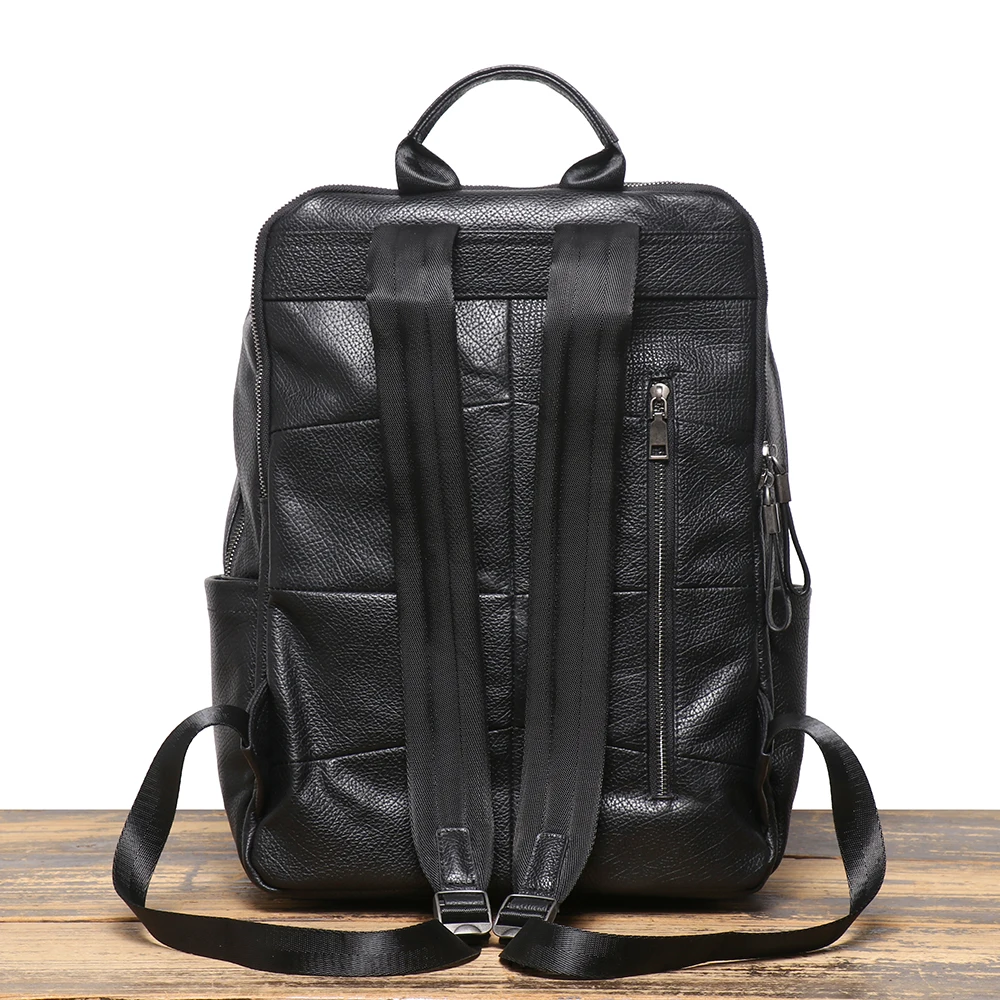
Preparation Phase
- Empty your backpack completely, checking all pockets and compartments
- Open all zippers and turn the bag inside out if possible
- Gently shake or vacuum to remove loose debris and dust
- Wipe down any fabric interior with a lightly damp cloth
- Identify your leather type to determine appropriate cleaning methods
Regular Maintenance Cleaning (Weekly)
Materials needed:
– Soft, dry microfiber cloth
– Soft-bristled brush (horsehair works well)Technique:
– Gently brush the entire surface to remove dust and surface dirt
– Pay special attention to seams, corners, and hardware attachments
– Wipe down with a dry microfiber cloth, following the natural grain of the leather
– Inspect for spots requiring deeper cleaning
Deep Cleaning Process (Monthly/Quarterly)
Materials needed:
– Leather cleaner appropriate for your leather type
– Microfiber cloths (several clean ones)
– Small bowl of room temperature water (for rinsing cloth only)Technique:
– Apply a small amount of leather cleaner to a damp (not wet) cloth
– Test on an inconspicuous area first
– Work in small sections using gentle circular motions
– Avoid oversaturating the leather
– Wipe away cleaner residue with a separate, slightly damp cloth
– Allow to air dry completely before conditioning
Learning how to clean leather backpack surfaces properly is essential for preventing long-term damage while removing accumulated dirt and oils.
Special Considerations for Different Leather Types
For Suede/Nubuck: Use a specialized suede brush or eraser. Brush in one direction to maintain consistent nap. Never use liquid cleaners designed for smooth leather.
For Patent Leather: Use a mild soap solution and non-abrasive cloth. Immediately dry with a clean cloth and finish with a specialized patent leather cleaner to restore shine.
Warning signs to stop cleaning include:
– Excessive color transfer to your cleaning cloth
– Leather becoming overly dark or saturated
– Any change in texture or appearance during cleaning
Tackling Common Stains: Targeted Stain Removal Techniques
Even with regular maintenance, accidents happen. Knowing how to address specific stains can save your leather backpack from permanent damage.
Water Stains
- Allow small water spots to air dry naturally
- For water rings or marks, lightly dampen the entire area evenly
- Allow to dry naturally away from direct heat
- Condition once completely dry
Oil & Grease Stains
- Blot excess oil immediately (don’t rub!)
- Sprinkle cornstarch or talcum powder generously over the stain
- Let it sit for 24 hours to absorb the oil
- Brush off powder gently
- Repeat if necessary
- Clean with leather cleaner once oil is absorbed
Ink Stains
- Act quickly—ink becomes more permanent with time
- For fresh stains, try rubbing alcohol on a cotton swab (test in hidden area first)
- Dab gently—never rub
- Seek professional help for set-in ink stains
- Consider a leather repair service for severe cases
Dirt & Mud
- Allow mud to dry completely
- Brush off dried mud with a soft brush
- Clean residual marks with appropriate leather cleaner
- For stubborn dirt stains, use a leather-safe soap with minimal water
Scuffs & Scratches
- For minor scuffs, gently rub with a clean finger (natural oils help)
- Use a leather conditioning cream to diminish the appearance
- For deeper scratches, apply leather balm and buff gently
- Match colored leather polish for scratches that expose lighter leather underneath
Implementing proper waterproofing for leather bags can prevent many future stains by creating a protective barrier against common substances.
Mold & Mildew
- Take outdoors to prevent spore spread
- Wipe with a cloth dampened with isopropyl alcohol diluted with water (test first)
- Allow to dry completely in a well-ventilated area
- Apply an anti-fungal spray designed for leather
- Condition after treatment
Nourishing Your Leather: The Art of Conditioning Your Backpack
Conditioning is perhaps the most critical aspect of leather maintenance. It replaces essential oils that prevent leather from drying, cracking, and deteriorating over time.
Purpose and Benefits of Conditioning
- Prevents leather from drying out and becoming brittle
- Restores natural oils depleted through use and cleaning
- Enhances suppleness and flexibility of the leather
- Improves resistance to moisture damage
- Develops and maintains a rich, healthy patina
- Extends the overall lifespan of your backpack
Types of Leather Conditioners
Creams:
– Best for regular maintenance
– Provide moderate moisturizing without oversaturation
– Easy to control application
– Excellent for most smooth leathers
Oils:
– Deep penetration for very dry leather
– Create more dramatic darkening effect
– Should be used sparingly to avoid oversaturation
– Good for rejuvenating vintage leather
Waxes:
– Provide conditioning and protection in one step
– Create more water resistance
– Leave a slightly more matte finish
– Better for outdoor-use backpacks
Some DIY leather care for travel backpacks can be effective in emergencies, but commercial products typically provide more consistent results without risking damage.
Application Techniques
- Ensure leather is clean and completely dry
- Apply a small amount of conditioner to a soft cloth (never directly to leather)
- Work in small sections using gentle circular motions
- Allow conditioner to absorb for the time recommended by the product (typically 15-30 minutes)
- Buff gently with a clean cloth to remove excess
- Allow 24 hours for complete absorption before using
Conditioning Frequency Guidelines
- Normal use in moderate climates: Every 3-6 months
- Frequent use or dry climates: Every 2-3 months
- Storage periods: Condition before storing long-term
- After cleaning: Always condition after deep cleaning
- Signs leather needs conditioning: Stiff feel, dull appearance, or visible dryness
Protecting Your Leather Backpack: Prevention is Key
After cleaning and conditioning, applying protection creates a barrier against water, stains, and environmental damage.
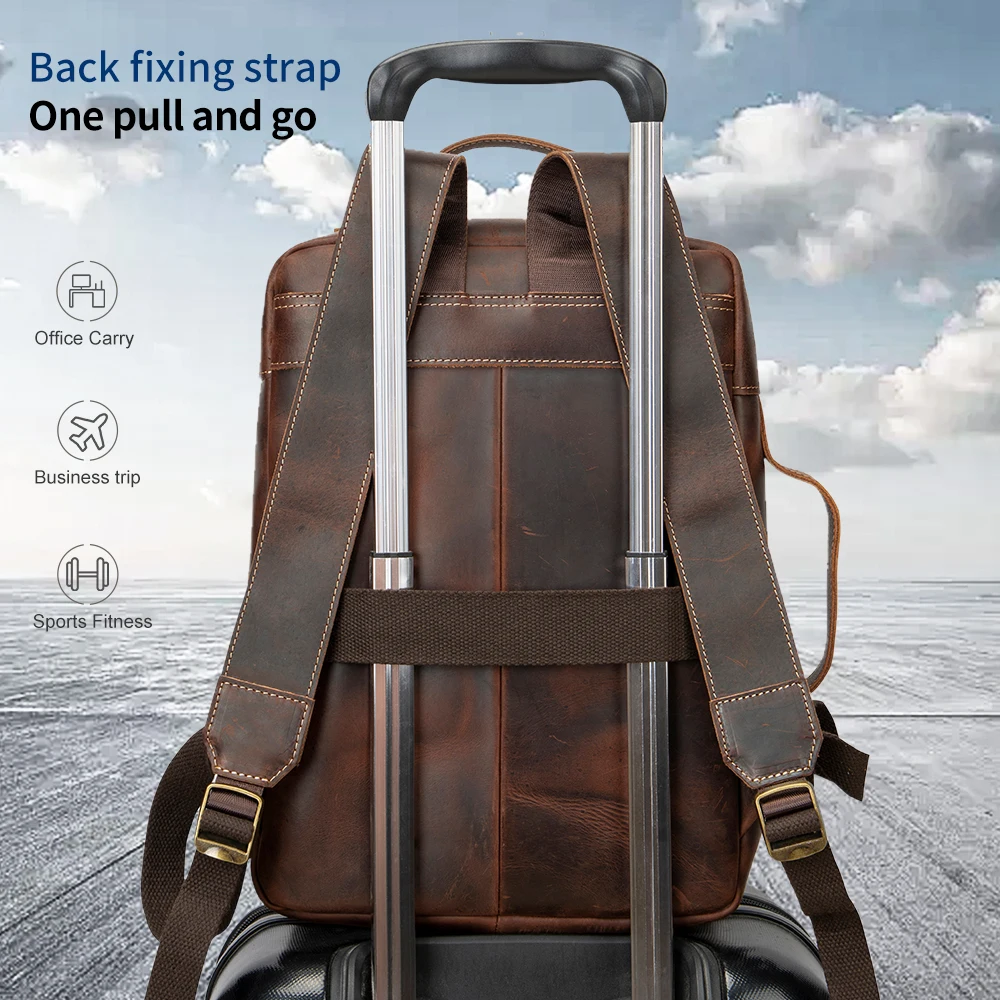
Types of Leather Protectors
Spray-On Products:
– Best for even application across large areas
– Excellent for textured leathers and hard-to-reach places
– Typically water-based or silicone-based formulations
– Allow for multiple light coats
Wipe-On Products:
– Better control for targeted application
– Often provide deeper protection
– Usually cream or wax-based
– Can enhance color while protecting
Application Process
- Always apply protector after conditioning and complete drying
- Ensure good ventilation—never apply in confined spaces
- For sprays:
– Hold bottle 6-8 inches from surface
– Apply in light, even passes
– Avoid oversaturation
– Allow to dry between coats (typically 15-30 minutes) - For wipe-on products:
– Apply thin layer with cloth using circular motions
– Focus on high-exposure areas (edges, top surfaces)
– Buff gently after recommended absorption time
Leather travel backpacks benefit particularly from regular protection treatment due to their exposure to varied environments and handling conditions.
Environmental Protection Strategies
- Avoid prolonged direct sunlight, which fades and dries leather
- Use rain covers during heavy downpours
- In winter, wipe salt residue immediately to prevent staining
- Avoid placing your backpack on rough or dirty surfaces
- Distribute weight evenly when packing to maintain shape
- Handle with clean hands to prevent oil transfer
Proper Storage of Your Leather Backpack When Not in Use
How you store your backpack when not in use significantly impacts its longevity and appearance.
Pre-Storage Preparation
- Clean thoroughly using appropriate methods for your leather type
- Condition completely and allow 24 hours for absorption
- Apply leather protector if storing long-term
- Ensure the backpack is completely dry inside and out
Shape Retention Methods
- Stuff interior with acid-free tissue paper or clean cotton fabric
- Pay special attention to:
– Main compartment to maintain overall structure
– Smaller pockets to prevent collapsing
– Straps and handles to prevent creasing - Avoid newspaper as the ink can transfer to leather or linings
Mastering small leather backpack organization before storage ensures that no areas remain compressed or creased during non-use periods.
Ideal Storage Environment
- Temperature: Cool to moderate (60-75°F/15-24°C)
- Humidity: Moderate (40-60% relative humidity)
- Light: Away from direct sunlight and artificial lights
- Air: Good circulation to prevent mold and mildew
- Position: Stand upright if possible, or lay flat with minimal pressure points
- Cover: Use breathable cotton dust bag—never plastic
Storage Duration Considerations
- Short-term (weeks): Standard cleaning and stuffing
- Medium-term (months): Add conditioning and protective treatment
- Long-term (seasons or years): All above plus quarterly checks and air-out sessions
Recommended Tools and Products for Optimal Leather Care
Having the right tools makes leather maintenance simpler and more effective.
Essential Cleaning Tools
- Microfiber Cloths: Non-abrasive, lint-free, and ideal for application and buffing
- Horsehair Brush: Soft bristles that remove dust without scratching smooth leather
- Suede Brush: Specialized brush with brass or rubber bristles for raising nap on suede
- Leather Cleaning Sponges: Gentle yet effective for surface cleaning
- Soft Toothbrush: Perfect for cleaning seams, corners, and hardware attachments
Quality Leather Cleaners
- pH-neutral formulations specifically designed for leather
- Saddle soap for traditional cleaning of smooth leathers
- Suede-specific cleaners that don’t mat the nap
- Specialized cleaners for exotic or delicate leathers
Leather Conditioners
- Natural options:
- Beeswax-based for water resistance and conditioning
- Lanolin-based for deep moisturizing
- Mink oil for weather protection (use sparingly—can darken leather)
- Synthetic options:
- Silicone-free formulations that don’t build up
- Neatsfoot compound for general conditioning
- pH-balanced moisturizing creams
Protection Products
- Water and stain repellents appropriate for your leather type
- UV protectants to prevent fading
- All-in-one products that offer conditioning and protection
- Edge sealants for exposed leather edges
Our collection of leather backpacks encompasses various leather types, each benefiting from specific care products designed for their unique properties.
14 Inch Leather Laptop Backpack, Brown Leather Backpack, Men's Leather Backpack, Vintage Leather Backpack
Price range: $177.28 through $199.12 Select options This product has multiple variants. The options may be chosen on the product pageCarry On Leather Backpack, Roll Top Leather Backpack
Price range: $77.76 through $96.48 Select options This product has multiple variants. The options may be chosen on the product pageDesigner Mini Backpack, Mini Leather Backpack, Small Leather Sling Backpack, Women's Leather Backpack
Price range: $95.76 through $98.80 Select options This product has multiple variants. The options may be chosen on the product pageDesigner Mini Backpack, Designer Women's Backpack, Mini Leather Backpack, Women's Leather Backpack
Price range: $135.92 through $137.64 Select options This product has multiple variants. The options may be chosen on the product page17 Inch Leather Laptop Backpack, Men's Leather Travel Backpack, Men's Leather Work Backpack
Price range: $106.28 through $143.88 Select options This product has multiple variants. The options may be chosen on the product pageBlack Leather Backpack, Small Leather Backpack, Women's Leather Backpack
Price range: $112.96 through $116.12 Select options This product has multiple variants. The options may be chosen on the product page
Specialty Items
- Leather dyes for touch-ups on scratches or worn areas
- Leather repair kits for small tears or punctures
- Leather edge coatings to reseal cut edges
- Hardware polish appropriate for brass, nickel, or other metals
Leather Backpack Maintenance Schedule: Creating a Care Routine
Establishing a regular maintenance schedule keeps your leather backpack in optimal condition with minimal effort.
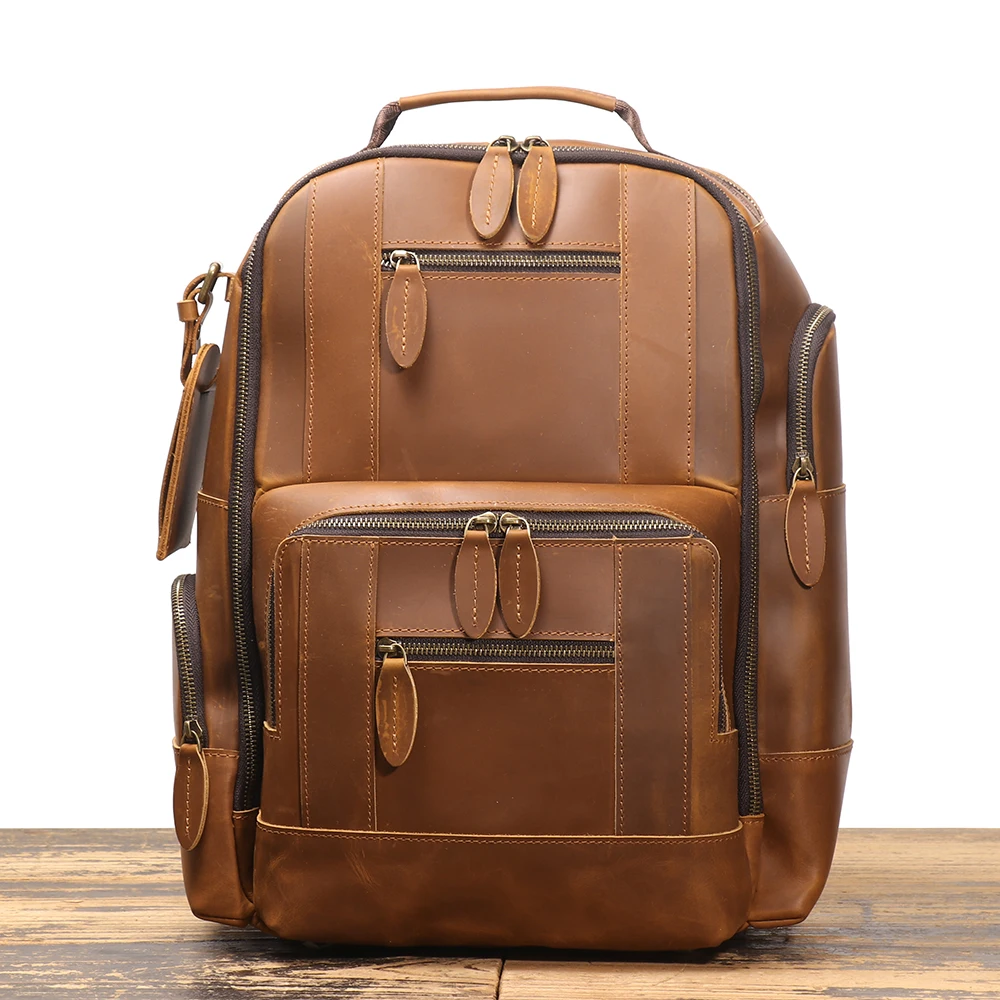
Daily/After Each Use
- Wipe down with soft, dry cloth
- Empty completely to maintain shape
- Hang on proper hook or stand upright
- Address any moisture or spills immediately
Weekly Maintenance
- Dust with soft brush or cloth
- Inspect hardware for issues
- Check for stains or spots needing attention
- Wipe with leather-specific wipes if needed
Monthly Care
- Surface clean with appropriate leather cleaner
- Check stitching and edges for wear
- Apply light conditioning if needed
- Inspect interior for cleanliness
Seasonal Maintenance (Every 3-4 Months)
- Deep clean exterior and interior
- Apply full conditioning treatment
- Add protective treatment
- Assess need for minor repairs
A common question among leather owners is whether oiling leather provides waterproofing benefits, which should be considered when developing your seasonal care routine.
Annual Assessment
- Complete all seasonal care steps
- Evaluate overall condition
- Address any significant wear areas
- Consider professional cleaning for valuable pieces
| Frequency | Care Tasks | Time Required |
|---|---|---|
| Daily/After Use | Quick wipe, proper storage | 2-3 minutes |
| Weekly | Surface dusting, spot inspection | 5-10 minutes |
| Monthly | Light cleaning, hardware check | 15-20 minutes |
| Seasonal | Deep clean, condition, protect | 30-45 minutes |
| Annual | Complete assessment, repairs | 1+ hours |
Adjust this schedule based on:
– How frequently you use your backpack
– Environmental conditions (humidity, pollution, etc.)
– Leather type and quality
– Age and condition of your backpack
FAQs About Leather Backpack Maintenance
How often should I clean my leather backpack?
Surface cleaning should happen weekly, with deeper cleaning every 1-3 months depending on use. If your backpack shows visible dirt or stains, clean it immediately regardless of schedule.
Can I use household products instead of leather-specific ones?
Generally not recommended. Household products often contain chemicals harmful to leather. In emergencies, mild soap with minimal water can work for smooth leather, but specialized products are always safer.
What should I do if my leather backpack gets soaked in rain?
Blot (don’t rub) excess water with an absorbent cloth, reshape gently, and allow to air dry naturally away from heat sources. Once completely dry, apply conditioner to restore oils lost during wetting.
Are all leather conditioners suitable for all leather types?
No. Suede and nubuck require specific products. Oil-based conditioners can oversaturate lightweight leathers. Always match the conditioner to your specific leather type and test in an inconspicuous area first.
How can I remove persistent odors from my leather backpack?
For musty smells, air out in indirect sunlight. For other odors, try activated charcoal or baking soda placed in an open container inside the closed bag for 24-48 hours. Never apply deodorizers directly to leather.
Is it safe to use olive oil or cooking oils on leather?
No. While temporary shine might result, cooking oils eventually turn rancid, causing odor and accelerated deterioration of leather fibers. Always use proper leather conditioners.
When should I seek professional leather restoration help?
Consider professional help for: significant color loss, deep structural cracks, major water damage, torn seams in stress areas, or valuable/sentimental pieces requiring expert care.
How do I clean the hardware on my leather backpack?
Use a slightly damp cloth for general cleaning. For tarnished metal, specific metal cleaners appropriate for your hardware type (brass, nickel, etc.) applied carefully with a Q-tip will avoid contact with surrounding leather.
Can I use leather care products on synthetic leather?
No. Synthetic leather (vegan leather) doesn’t absorb conditioners like genuine leather and can be damaged by them. Use cleaners specifically formulated for synthetic materials.
How do I know if I’m over-conditioning my leather backpack?
Signs include: sticky surface, darkening beyond initial conditioning color change, greasy feel that doesn’t dissipate after buffing, or leather that feels too soft and stretchy.
Extending Your Leather Backpack’s Lifespan: Repair Basics and When to Seek Professional Help
Even with excellent care, leather backpacks eventually need repairs. Knowing which issues you can address yourself versus when to seek professional help saves both your backpack and your budget.
Common Minor Issues Suitable for DIY Repair
- Small surface scratches
- Minor scuffs and marks
- Slight color fading in small areas
- Loose (but not broken) stitching
- Simple hardware issues like stuck zippers
- Edge coating wear
Basic Repair Techniques
For scratches and scuffs:
– Clean area thoroughly
– Apply matching color shoe polish or leather cream
– Buff gently to blend with surrounding leather
– Finish with conditioner
For edge wear:
– Clean edge thoroughly
– Apply thin coat of edge kote or leather paint
– Allow to dry completely between coats
– Seal with leather sheen if desired
Many vintage leather backpack owners become skilled at these minor restoration techniques, extending the character-filled life of their aged leather goods.
Signs That Professional Repair Is Needed
- Structural damage affecting use or integrity
- Torn stitching at stress points (handles, straps)
- Significant color loss requiring redyeing
- Deep cuts or tears in the leather
- Broken hardware requiring replacement
- Water damage that has hardened or warped the leather
- Mold damage that persists after cleaning attempts
Finding Qualified Leather Repair Professionals
- Look for specialists in leather goods rather than general repair shops
- Ask about experience with high-quality leather backpacks specifically
- Request examples of similar repairs they’ve completed
- Inquire about techniques and materials they use
- Get clear pricing before authorizing work
With proper care and timely repairs, your leather backpack can remain a trusted companion for decades, developing character while maintaining functionality and beauty.
